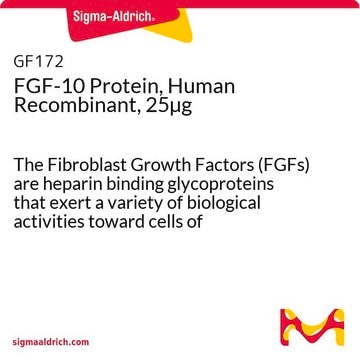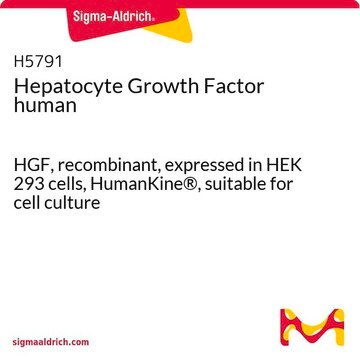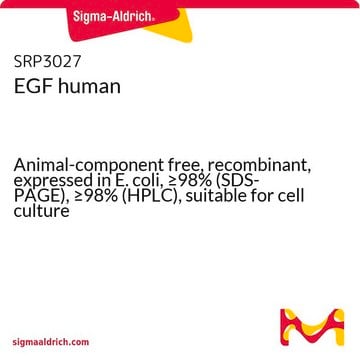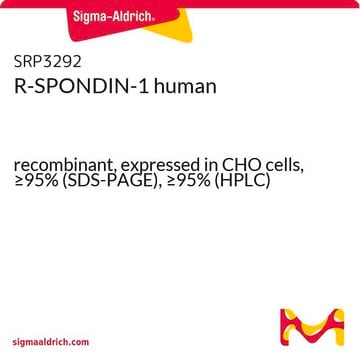F8924
Fibroblast Growth Factor-10 human
>97% (SDS-PAGE), recombinant, expressed in E. coli, lyophilized powder, suitable for cell culture
Synonym(s):
FGF-10
Sign Into View Organizational & Contract Pricing
All Photos(1)
About This Item
Recommended Products
biological source
human
Quality Level
recombinant
expressed in E. coli
Assay
>97% (SDS-PAGE)
form
lyophilized powder
potency
28 ng/mL
mol wt
19 kDa by SDS-PAGE
packaging
pkg of 25 μg
storage condition
avoid repeated freeze/thaw cycles
technique(s)
cell culture | mammalian: suitable
impurities
endotoxin, tested
UniProt accession no.
storage temp.
−20°C
Gene Information
human ... FGF10(2255)
General description
FGF10 (fibroblast growth factor 10) is a member of the FGF protein family, which is a mitogen of epithelial origin and has a paracrine activity. It is produced by mesenchymal lineage cells, and acts as a ligand for FGFR, most notably FGFR2b, which is expressed by epithelial cells.
Application
Fibroblast Growth Factor-10 human is suitable for culturing of HUVEC cell line (human umbilical vein endothelial cells) to determine the anti-angiogenic properties of sFLT-1 (soluble fms-related tyrosine kinase-1).
Biochem/physiol Actions
FGF10 (fibroblast growth factor 10) is involved in cell growth, morphogenesis and embryogenesis. It plays an essential role in initiating the formation of limb bud, lung morphogenesis and brain formation during embryogenesis. It acts as a mitogen, where it facilitates the regeneration of epithelia post-bladder urothelial injury. Thus, it might have future applications during bladder transplantation. Studies in Japanese population show that polymosphisms- rs339501, rs12517396, and rs10462070 are linked with severe myopia, and might act as susceptibility factors for the same. In lung cancer cells, FGFR4 reduces the stem cell/self-renewal property of cancer cells, and makes them more susceptible to chemotherapy.
Physical form
Lyophilized from a 0.2 μm filtered solution in 20 mM MOPS, 50 mM sodium sulfate, 1 mM DTT, 0.5 mM EDTA, pH 7.2, containing 50 μg bovine serum albumin per 1 μg cytokine.
Analysis Note
The biological activity is measured by its ability to stimulate the proliferation of a monkey epithelial cell line 4MBr-5.
Storage Class Code
13 - Non Combustible Solids
WGK
WGK 1
Flash Point(F)
Not applicable
Flash Point(C)
Not applicable
Certificates of Analysis (COA)
Search for Certificates of Analysis (COA) by entering the products Lot/Batch Number. Lot and Batch Numbers can be found on a product’s label following the words ‘Lot’ or ‘Batch’.
Already Own This Product?
Find documentation for the products that you have recently purchased in the Document Library.
Customers Also Viewed
Poopak Farnia et al.
International journal of clinical and experimental medicine, 8(1), 1526-1533 (2015-03-19)
The soluble vascular endothelial growth factor receptor-1 (VEGFR1) or sFLT-1 has important role in antiangiogenesis. In this study, the increase expression and production of sFLT-1 fragment by newly designed ChPL-NPs nanoparticles (chitosan-protein lipid) using Chinese hamster ovary cell line (CHO)
Masao Yoshida et al.
Molecular vision, 19, 2321-2329 (2013-11-23)
The fibroblast growth factor 10 (FGF10) gene polymorphism rs339501 was previously reported to be associated with high myopia in a Chinese population. In the present study, we investigated whether FGF10 polymorphisms are associated with extreme myopia in a Japanese population
Seyung S Chung et al.
In vitro cellular & developmental biology. Animal, 49(10), 746-751 (2013-08-21)
Fibroblast growth factor 10 (FGF10) is required for embryonic epidermal morphogenesis including brain development, lung morphogenesis, and initiation of limb bud formation. In this study, we investigated the role of FGF10 as a lead induction factor for stem cell differentiation
H Ohuchi et al.
Development (Cambridge, England), 124(11), 2235-2244 (1997-06-01)
Vertebrate limb formation has been known to be initiated by a factor(s) secreted from the lateral plate mesoderm. In this report, we provide evidence that a member of the fibroblast growth factor (FGF) family, FGF10, emanates from the prospective limb
S Tagashira et al.
Gene, 197(1-2), 399-404 (1997-10-23)
We cloned the mouse homolog of FGF10, which was recently reported as a new member of the FGF family. The predicted molecular mass of this molecule is 23.6 kDa, and both nucleotide and amino acid sequences show high degrees of
Our team of scientists has experience in all areas of research including Life Science, Material Science, Chemical Synthesis, Chromatography, Analytical and many others.
Contact Technical Service












